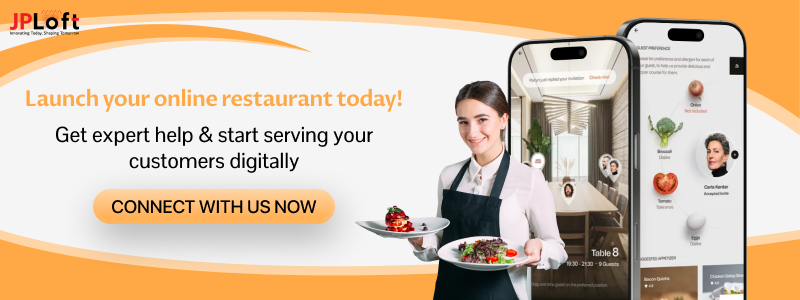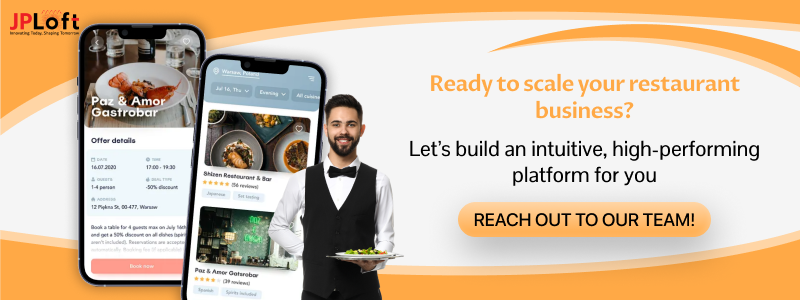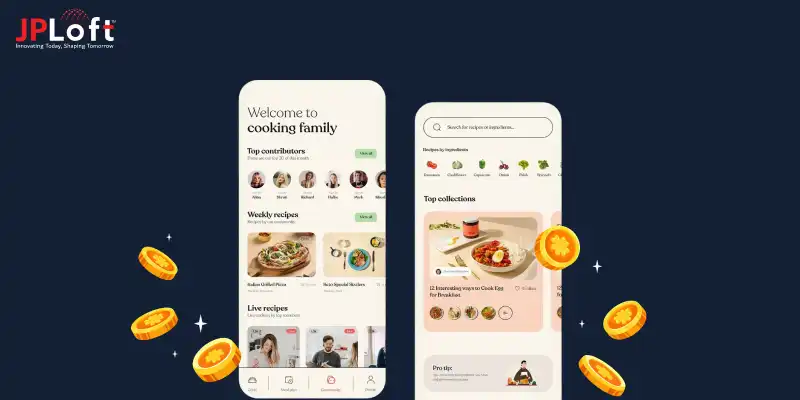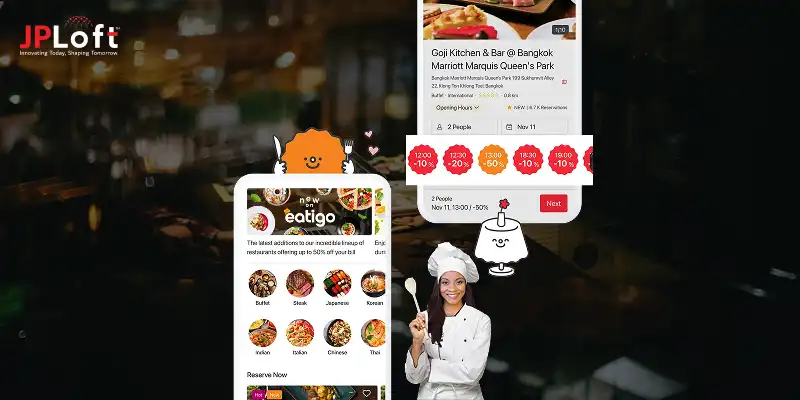Thinking about starting an online restaurant business? Now’s the perfect time.
With more customers ordering food online than ever, foodpreneurs, home chefs, and even dine-in restaurants are going digital.
You don’t need a physical storefront or full waitstaff—just a solid food idea, smart technology, and the right strategy.
Online restaurant models like ghost kitchens and cloud kitchens are booming, driven by convenience, speed, and rising demand.
In fact, the global online food delivery market is expected to surpass $500 billion by 2030 and your concept could be part of that growth.
This guide walks you through everything, from setup and costs to monetization and tools.
Let’s build your digital restaurant dream.
What Is an Online Restaurant Business? A Quick Overview
An online restaurant business is a food venture that operates digitally—no dine-in space, just apps, websites, and delivery.
Instead of serving customers at tables, you prep meals in a home or cloud kitchen and deliver them via platforms like Uber Eats, DoorDash, or your own app.
This model skips the costs of real estate and front-of-house staff, making it ideal for foodpreneurs who want to start small and scale fast.
Orders, branding, and customer engagement all happen online—through smart tech, social media, and standout packaging.
Think of it as an eCommerce store for food: fast, flexible, and built for today’s mobile-first customer.
Why Start an Online Restaurant Business in 2025?
Starting a traditional brick-and-mortar restaurant in 2025 feels a bit like buying a DVD player in the age of Netflix. Sure, it can work—but why invest in high overheads when your audience is already scrolling and ordering straight from their phones?
There are plenty of good reasons why starting an online restaurant business makes way more sense today than ever before. Here are four that really stand out:
1. Massive Market Growth (Backed by Data)
The food delivery industry is exploding. As mentioned earlier, the global online food delivery market is expected to cross $500 billion by 2030. That means more people want food that fits into their digital lives—on-demand, app-based, and fast.
This trend gives modern entrepreneurs the perfect runway to launch a mobile-based restaurant service that caters to customers’ convenience.
If you're planning to go digital, make sure to also consider how you'll develop a restaurant app to manage orders, menus, payments, and feedback—all from one place.
2. Low Startup Costs (Compared to Traditional Restaurants)
Rent, interiors, waitstaff, and utilities? Not your problem. A home-based restaurant venture can run out of a shared cloud kitchen, a home kitchen, or even a rented space for just a few hours a day.
You're cutting out major overheads while still reaching thousands of customers through online platforms and food apps. That means lower risk, higher margins, and more freedom to experiment.
3. Built for the Digital Customer
Today’s diners don’t just want good food. They want smart digital experiences. That means:
-
Ordering through apps
-
Tracking delivery in real time
-
Getting personalized offers
This is where the online-only restaurant model really shines. It meets people where they already are: on their phones.
4. Scalability Without Storefront Stress
Opening a second location used to mean doubling your investment. With an online restaurant, scaling can be as simple as launching a new menu or expanding delivery zones.
Even better? You can test and pivot fast. Want to try a vegan-only menu? Launch it as a digital brand and track the response. No need for a full-blown launch event or a new lease agreement.
So yes, the online restaurant model is flexible and scalable—but that doesn’t mean you can wing it.
Just because you don’t need a storefront doesn’t mean you don’t need structure. Behind every successful cloud kitchen or delivery-first brand is careful planning, testing, and setup.
Before you launch, here are the must-do things to lay a solid foundation for your digital food venture.
Things You Must Do Before Starting a Restaurant Business
Before you jump into the world of digital dining, let’s hit pause.
Because while an online restaurant business may sound lean and agile (and it is), you still need to prep smart before launch day.
Here’s your essential checklist — do these things first, and you’ll be setting yourself up for a much smoother ride.
► Decide on the Right Restaurant Model
Not all virtual restaurants follow the same recipe.
Will you operate out of a ghost kitchen? Rent a shared space? Or go all-in on a home-based restaurant venture?
Figure out your operational setup early. The model you choose will affect everything—from licensing and logistics to how you market yourself and scale later on.
► Design a Delivery-First Menu
Here’s the truth: not every dish loves a delivery box.
Build a menu that travels well, holds heat, and still makes people crave a second order.
Think concise, crave-worthy, and cost-efficient. It’s a balance between flavor and function.
This is also a great time to do competitor research and spot gaps in your local market.
► Know Who You’re Feeding
Your target audience isn’t “everyone who eats.”
Are you serving busy professionals, college students, health-conscious parents, or late-night snackers?
Knowing your niche helps you create a restaurant business online that actually connects and converts.
► Sort Your Tech Game Early
If you’re planning to build your own app (which we highly recommend), this part’s a dealbreaker.
You'll need features like:
-
Clean, user-friendly ordering
-
Delivery tracking
-
Loyalty rewards or referral bonuses
-
Payment gateway integration
Set your tech budget based on your goals, not just what’s trendy or what your competitors are doing.
Also, don’t underestimate the time and energy saved by working with experienced partners. Once your vision is clear, team up with the best mobile app development company that understands the restaurant space. It’ll reduce costly revisions, improve feature quality, and help you launch faster with fewer hiccups.
► Get Your Licenses and Legalities in Order
Just because you don’t have a dining area doesn’t mean you’re off the hook.
Food safety, health inspections, and business registrations still matter—and skipping this part can shut you down faster than a bad Yelp review.
Take it seriously. Future-you will thank you.
► Build Your Brand (Before You Cook Anything)
Your logo, website, and social presence don’t have to be flashy, but they do have to be consistent and trustworthy.
People don’t just eat with their mouths anymore—they eat with their eyes and trust their screens. Make sure your online identity reflects the quality of what you’re serving.
Do all of this before you even fire up the stove, and you’ll be ahead of 80% of newcomers trying to set up an online restaurant business without a plan.
Next up: the actual steps to launch your online restaurant like a pro.
Steps to Start an Online Restaurant Business
Think of this as your startup guide for restaurant delivery service success. Whether you’re launching from a shared kitchen or your own home, here’s how to start your restaurant business step by step and get things cooking (literally and figuratively).
Step 1: Choose Your Concept and Cuisine
First things first: what are you serving, and why should anyone care?
Find your sweet spot:
-
Is it Thai street food, keto bowls, or late-night comfort eats?
-
Is your brand quirky, premium, family-friendly, or eco-conscious?
Pick a theme that reflects your values and fills a local or digital demand. This forms the core of your online dining business identity.
Step 2: Research Your Audience and Competition
Know your people—and your rivals.
Use online food platforms to study what’s trending, what sells, and what’s missing. Target a customer base you can actually reach and retain.
Pro tip: Check reviews of your competitors. They’ll tell you what people love—and what they desperately wish someone would fix.
Step 3: Select a Business Model That Fits Your Goals
Before setting up your kitchen, decide how your customers will interact with your brand.
Will you run your online restaurant through:
-
A food delivery aggregator like Uber Eats or DoorDash?
-
A custom-built website?
-
A full-featured mobile app?
-
Or a combination of all three?
Start simple if you're testing the waters. But if scaling is your goal, an app gives you full control over branding, data, and customer loyalty.
Choose what fits your budget and vision—many restaurants begin with one platform and expand over time.
Step 4: Finalize the Right Kitchen Setup
Whether it’s a cloud kitchen, ghost kitchen, or your own licensed space, you’ll need to sort out:
-
Food safety permits
-
Local business licenses
-
Delivery partner requirements
-
Hygiene and packaging standards
This setup determines how fast (and how far) you can scale. Get this right, and you’ll be ready to confidently set up your digital restaurant business with fewer hiccups later.
Step 5: Create Your Digital Ordering Experience
No app, no business.
Your customers are ordering through phones, so your platform needs to be flawless.
From the moment they open your app to the time their food arrives, everything should feel smooth, fast, and reliable.
Looking for examples? Check out how successful restaurant app platforms manage things like:
-
Real-time order tracking
-
Secure, one-tap payments
-
Easy menu browsing with pictures
-
Feedback collection and loyalty points
If tech isn’t your forte, don’t worry. You can always hire dedicated developers who specialize in restaurant apps. They’ll help ensure your platform is scalable, user-friendly, and packed with the right features from day one.
Step 6: Build a Strong Brand Online
You don’t need a storefront, but you do need brand presence.
Get:
-
A memorable name
-
A drool-worthy logo
-
A consistent voice across your website, app, and social media
Make your food feel like more than just a product—make it a vibe.
Step 7: Launch, Test, Improve, Repeat
Now it's time to
But don’t worry about perfection—worry about progress.
Start small. Take initial orders. Gather feedback. Refine your packaging, timing, and menu. A soft launch lets you fix issues before the real buzz hits.
Remember, to create an online restaurant business that lasts, you need to stay flexible and customer-focused from day one.
You’re not just launching food—you’re launching an experience.
One bite, one order, and one five-star review at a time.
Next Section: Want to see how the pros are doing it? We’ll break down real-world case studies of top online restaurant businesses next.
Successful Restaurant App Businesses and How They Made It
If you're planning to start an online restaurant business, there’s no better way to learn than by studying those who’ve already built digital food empires.
The brands below didn’t just cook up great food—they launch and scale restaurant businesses online with serious tech, data, and strategy. Let’s explore how.
1] Rebel Foods (India, Global)
-
- What They Do: Rebel Foods operates multiple cloud kitchen brands like Faasos, Behrouz Biryani, and Oven Story—all under one digital roof.
- Why It Matters: They're the world's largest internet restaurant company, running over 450 kitchens across 10+ countries.
- Business Model: Cloud kitchen + multi-brand delivery-first dining
- Success Factor: One kitchen, many brands—efficient, scalable, and deeply data-driven
- Tech Strength: Automated kitchens + single app managing multiple virtual brands
2] Sweetgreen (USA)
-
- What They Do: Sweetgreen is a fast-casual health food chain known for salads and bowls, built around sustainability and digital-first experiences.
- Why It Matters: It's one of the few “salad chains” that scaled nationally using tech, personalization, and strong branding.
- Business Model: Health-forward quick service with mobile-first customer journeys
- Success Factor: Turned clean eating into a lifestyle experience
- Tech Strength: Personalized ordering, rewards, and seamless pick-up features
3] Domino’s (Global)
-
- What They Do: Domino’s is a legacy pizza chain that evolved into a digital ordering giant, with a focus on delivery and app-based convenience.
- Why It Matters: They proved that old-school chains can outpace startups when t199hey prioritize tech.
- Business Model: Brick-and-mortar turned digital-first food delivery leader
- Success Factor: Convenience, loyalty, and ultra-fast delivery experience
- Tech Strength: Real-time GPS tracking, voice ordering, and smart reorders
4] OpenTable (Global)
-
- What They Do: OpenTable is a restaurant reservation platform that allows users to book tables online at restaurants around the world.
- Why It Matters: It reinvented the restaurant reservation experience and supports both diners and restaurant owners with smart tools.
- Business Model: SaaS-style reservation and CRM platform
- Success Factor: User ease + back-end efficiency for restaurants
- Tech Strength: Real-time bookings, smart table management, analytics
Curious what it takes to build something like this? Here’s a look at the cost to build a restaurant reservation app like OpenTable.
5] Taster (Europe)
-
- What They Do: Taster operates a portfolio of digital-only food brands like Out Fry and Pepe Chicken, designed for delivery and powered by local kitchens.
- Why It Matters: They scale fast by tapping into local cravings and keeping overheads low.
- Business Model: Cloud kitchen-based virtual restaurants
- Success Factor: Niche-focused brands + low investment = rapid market entry
- Tech Strength: Data-led menu testing, agile kitchen setup, local influencer marketing
6] ChowNow (USA)
-
- What They Do: ChowNow offers white-label ordering solutions for restaurants that want to own their online presence instead of relying on aggregators.
- Why It Matters: It's empowering small and mid-sized restaurants to build their digital storefronts with full control.
- Business Model: SaaS platform for independent restaurant ordering systems
- Success Factor: Gives restaurants power over branding, profits, and customer data
- Tech Strength: POS integrations, loyalty programs, branded apps & websites
These best restaurant app case studies prove that you don’t need a physical storefront to dominate the food scene.
You just need the right concept, the right tech, and a customer-first mindset.
How Much Does It Cost to Start an Online Restaurant?
Let’s talk money—because whether you’re launching from your home kitchen or renting a shared cloud space, budgeting is everything.
The good news? Compared to traditional restaurants, starting an online restaurant business can be far more cost-effective. But that doesn’t mean it’s cheap.
Here’s a breakdown of the major cost components you’ll need to consider to build a digital restaurant business that actually works.
1. Kitchen Setup & Equipment
If you're using a home kitchen, your costs will be minimal. But for most, a cloud kitchen or shared kitchen space is the go-to.
-
Home setup: $500–$3,000 (basic appliances, safety upgrades)
-
Cloud kitchen rental: $1,000–$5,000/month (varies by location, size, and facilities)
-
Commercial-grade kitchen equipment: $5,000–$20,000
This is where working with cloud kitchen app builders can help reduce logistics and costs by providing all-in-one infrastructure.
2. Packaging & Ingredients
Delivery packaging isn’t just a box—it’s your brand’s first impression.
-
Biodegradable or custom-printed packaging can cost more, but boost branding.
-
Ingredient costs vary by menu type but typically fall in the $2–$6 per order range.
Always factor in quality, durability, and spill protection.
3. App & Tech Development
Here’s where you want to invest smart, not just cheap. A well-built app makes or breaks the customer experience.
Depending on complexity, the cost to develop a restaurant app can range widely:
-
Basic app (ordering, payment): $5,000–$10,000
-
Mid-tier app (real-time tracking, loyalty, reviews): $12,000–$25,000
-
Advanced platform (AI, analytics, marketing tools): $30,000+
Not ready to go fully custom? You can also build a white-label restaurant ordering app, which offers the core features of a custom solution—branded for your business—at a much lower cost and faster turnaround.
But keep in mind—tech brings with it a list of restaurant app development challenges like scalability, security, integrations, and ongoing maintenance. Don’t ignore them, or you’ll pay later.
4. Licensing & Legal Costs
Even online kitchens require:
-
Business registration: $100–$500
-
Food service license or health permits: $200–$2,000
-
Insurance: $500–$2,500/year, depending on your region and model
Always check local requirements—going digital doesn’t mean going license-free.
5. Marketing & Launch Campaigns
To attract your first 1,000 customers, you’ll likely need:
-
Social media ads
-
Influencer partnerships
-
Promotions (like BOGO, free delivery, etc.)
Start with a lean budget of $500–$2,000 for initial traction, then scale based on ROI.
Average Estimated Startup Cost Range:
|
Model Type |
Estimated Startup Cost |
|
Home-based kitchen + 3rd-party apps |
$3,000 – $8,000 |
|
Cloud kitchen + basic custom app |
$10,000 – $25,000 |
|
Full-stack brand with advanced app |
$30,000 – $50,000+ |
If you’re aiming to build a digital restaurant business that scales fast and stays ahead, smart tech and strong branding will eat up the biggest chunk of your budget—but they’re also your biggest ROI drivers.
Top Challenges in Starting an Online Restaurant Business
Let’s be real—venturing into the restaurant business, even digitally, isn’t a walk in the park (or a stroll through your cloud kitchen). While you don’t have to lease expensive real estate or decorate a dining space, you still face a unique set of challenges when building an internet-based restaurant business.
Here are five big hurdles that most digital foodpreneurs run into—and what you can do to stay ahead of them.
A] Building Trust Without a Physical Presence
In a restaurant without a storefront, you don’t get to impress customers with fancy interiors or smiling waitstaff. Your branding, packaging, food quality, and digital interface have to do all the talking.
Quick fix: Focus heavily on visual appeal—great photos, slick UI, and 5-star customer service from day one.
B] Delivery Logistics and Order Accuracy
Let’s face it—delivery is your entire business model.
You’re relying on third-party drivers, real-time syncing, and kitchen speed. A single cold meal or missing item can turn into a bad review that hits hard.
Solution: Start with limited delivery zones, test systems with dummy orders, and use tech that allows real-time order tracking and delay notifications.
C] Keeping Up With Tech Trends (Without Breaking the Bank)
Tech moves fast, and food delivery apps are no exception.
From AI chatbots and voice ordering to drone deliveries, it can feel overwhelming to keep up.
Staying in tune with restaurant app development trends can help you prioritize. Not every trend is worth chasing, but ignoring innovation altogether is a recipe for irrelevance.
Pro tip: Build a flexible app infrastructure so you can scale or upgrade features without starting from scratch every time.
D] Online Visibility in a Crowded Market
You're not just competing with other cloud kitchens—you’re competing with pizza chains, salad bars, and even grandma’s Instagram-famous cupcake store.
What works: Hyper-targeted local SEO, mouth-watering photos, influencer collabs, and referral incentives. Don’t just blend in—stand out digitally.
E] Scaling Without Losing Quality
It’s tempting to expand fast when orders spike—but going from 20 to 200 daily orders can wreck your kitchen ops if you're not ready.
Plan for growth: Document your recipes, standardize prep, and automate where possible. Your digital-first restaurant strategy should include scaling systems before sales explode.
Quick Reality Check:
|
Challenge |
What’s at Stake |
|
No storefront |
Low customer trust |
|
Messy delivery |
Lost loyalty & bad reviews |
|
Ignoring tech trends |
Falling behind competitors |
|
Low visibility |
No orders = no growth |
|
Poor scalability |
Compromised quality & burnout |
Yes, it's tough—but you're not alone.
Most successful founders faced these challenges and came out stronger by adapting, testing, and constantly improving.
How to Monetize Your Online Restaurant Business?
You’ve set up the kitchen. You’ve launched the app. Orders are flowing. But the real question is: how do you create an online restaurant business that’s actually profitable, not just popular?
Here’s a breakdown of smart, scalable restaurant app’s monetization strategies that help you go beyond just selling food and start building a sustainable brand.
1] Direct-to-Customer Sales (Your Primary Revenue Stream)
Let’s start simple: someone orders food, you fulfill it, you make money.
But the real edge of the app-powered restaurant model is that you're not sharing margins with physical rent, waitstaff, or even big delivery platforms (if you have your own system).
Pro tip: Optimize margins by pricing for delivery (not dine-in), streamlining packaging, and upselling add-ons like drinks, sides, or combos.
2] Premium App Features
If you’ve built your own app—or plan to—there are endless ways to turn it into a money-making machine using top restaurant app features like:
-
Priority delivery options (for a fee)
-
Meal subscriptions or pre-order meal packs
-
In-app tipping
-
Loyalty points or referral bonuses tied to spend
These not only improve revenue, but also increase customer lifetime value (CLV).
3] B2B Catering or Corporate Tie-Ups
Think bigger than individual orders.
Offer meal plans for offices, events, or local co-working spaces. These bulk orders often come with recurring demand and higher order value, and they’re easier to plan in advance.
Create a separate “Catering” tab in your app or website to simplify B2B onboarding.
4] Paid Promotions on Your App or Website
If your app gains traction, you can allow local vendors (e.g., beverage brands, dessert add-ons, etc.) to advertise within your platform.
This ad space can become a passive income stream, especially if you cater to a niche audience (like vegan or fitness-focused eaters).
5] Partner with Local Brands for Cross-Promotions
Think: combos with a nearby bubble tea shop or a discount code when someone orders dessert from your brand, + a salad from another cloud kitchen.
These co-branded partnerships drive mutual traffic and split marketing costs, without you having to build new products.
Why Start an Online Restaurant Business? Because It’s Built for Monetization.
You don’t need to wait for a line out the door to scale.
With the right model, online restaurants can monetize at multiple touchpoints, build long-term loyalty, and generate predictable revenue.
Smart Ways to Outshine the Competition
The food delivery space is booming—but it’s also packed. To really stand out, you need more than tasty food. You need a strategy. You need tech. And you need that “wow” factor that customers can’t ignore.
Here are three powerful tips to help you launch and scale your restaurant business online—better, faster, and smarter than your competition.
Tip 1: Use AI to Personalize the Dining Experience
AI isn’t just for big chains anymore. With smart tools, you can:
-
Recommend dishes based on past orders.
-
Offer personalized discounts or loyalty rewards.
-
Predict peak ordering times and streamline prep.
In fact, AI in restaurant apps is one of the fastest-growing tech trends in food delivery. It’s a game-changer when it comes to customer engagement and operational efficiency.
Tip 2: Focus on Hyperlocal Branding
Trying to appeal to “everyone” is a losing game.
Instead, tailor your brand to a specific niche or community, like vegan millennials, fitness freaks, or midnight snackers. Give your menu a story, your packaging a personality, and your brand a vibe.
This is how low-budget, digital-first restaurant strategies manage to outperform big names—they hit exactly the right audience with exactly the right energy.
Tip 3: Automate Early, Scale Faster
If you're serious about growing, you can't afford to manually manage orders, inventory, or customer messages forever.
Use automation tools from day one:
-
Auto-confirm orders
-
Auto-reply to common customer questions
-
Track stock in real time
This not only saves time, but it also reduces human errors and keeps your brand experience smooth as butter.
Think of it as the backbone of a low-investment restaurant concept that scales without needing 20 extra hands.
And if you’re looking to simplify all this from one platform, it’s probably time to create a mobile app that does the heavy lifting for you—customers will love it, and so will your staff.
Build Your Restaurant Business Online with JPLoft
Got a food concept and want to take it online?
At JPLoft, we help foodpreneurs, virtual kitchens, and delivery startups build a restaurant business online that’s scalable, user-friendly, and future-ready.
As a trusted restaurant app development company, we specialize in building tailor-made platforms—from real-time order tracking and secure payments to loyalty features and performance analytics.
Need help defining your vision? Our expert team will guide you through every stage—planning, development, launch, and beyond.
Let’s bring your digital food venture to life—smart, seamless, and built for success.
Conclusion: Ready to Start Your Online Restaurant Business?
The future of food is no longer limited to dine-in spaces or foot traffic. It’s online, on-demand, and driven by smart technology.
Now that you’ve seen how to start an online restaurant business—from understanding the model to setting up your kitchen, managing logistics, tackling challenges, and exploring monetization—one thing is clear: there’s real opportunity here.
With the right concept, a digital-first mindset, and the right team by your side, you can launch and scale your restaurant business online faster and smarter than ever before.
So whether you're dreaming up a home-based kitchen or diving into a full-blown online restaurant business, there’s never been a better time to begin.
Your journey starts now—let’s build something delicious, digital, and in-demand.
FAQs
Nope! That’s the beauty of an online restaurant. You can operate entirely from a home kitchen, shared cloud kitchen, or rented commercial space—whatever suits your budget and goals. The focus is on delivery, not dine-in.
Not necessarily. Starting small with a home setup or shared kitchen can be very cost-effective. Costs rise if you invest in a custom app, marketing, and high-end packaging, but the model is still cheaper than a traditional restaurant.
You’ll typically need a business license, food safety or health permits, and liability insurance. Exact requirements vary based on location, so always check with your local health department or legal advisor.
If you're using existing platforms, you can be up in a few weeks. If you’re building your own app or brand, expect 2–3 months for planning, setup, development, and marketing prep.
Food that travels well! Think rice bowls, burgers, pasta, salads, wraps, or desserts that don’t get soggy or lose quality during delivery. Menu simplicity and packaging design are key.













Share this blog